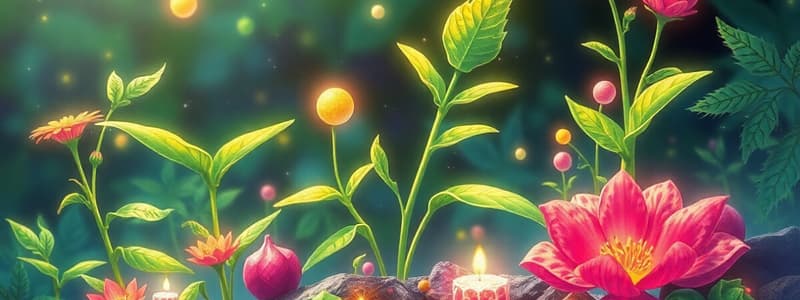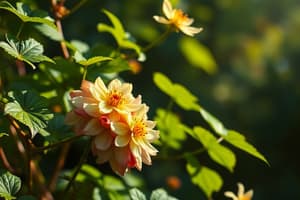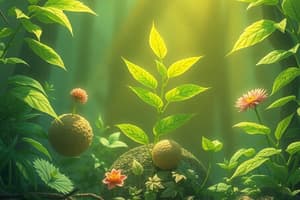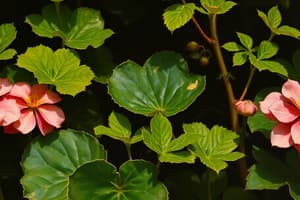Podcast
Questions and Answers
The components of food such as carbohydrates, proteins, and fats are called ______.
The components of food such as carbohydrates, proteins, and fats are called ______.
nutrients
Organisms that can make food themselves from simple substances are ______.
Organisms that can make food themselves from simple substances are ______.
autotrophic
Organisms that take in food prepared by plants or other organisms are called ______.
Organisms that take in food prepared by plants or other organisms are called ______.
heterotrophs
The process by which plants make their own food using sunlight, water, and carbon dioxide is known as ______.
The process by which plants make their own food using sunlight, water, and carbon dioxide is known as ______.
The tiny pores on the surface of leaves through which gases exchange are called ______.
The tiny pores on the surface of leaves through which gases exchange are called ______.
Leaves have a green pigment called ______ which helps in capturing energy from sunlight.
Leaves have a green pigment called ______ which helps in capturing energy from sunlight.
The ultimate source of energy for all living organisms is the ______.
The ultimate source of energy for all living organisms is the ______.
Plants synthesize carbohydrates using carbon dioxide and water in the presence of sunlight and ______.
Plants synthesize carbohydrates using carbon dioxide and water in the presence of sunlight and ______.
Besides carbohydrates, plants also synthesize other components of food such as proteins and ______.
Besides carbohydrates, plants also synthesize other components of food such as proteins and ______.
Plants cannot absorb nitrogen directly from the air, but certain ______ in the soil can convert it into a usable form.
Plants cannot absorb nitrogen directly from the air, but certain ______ in the soil can convert it into a usable form.
Plants that derive nutrition from dead and decaying matter are called ______.
Plants that derive nutrition from dead and decaying matter are called ______.
The mode of nutrition in which organisms take in nutrients from dead and decaying matter is called ______ nutrition.
The mode of nutrition in which organisms take in nutrients from dead and decaying matter is called ______ nutrition.
The insect-eating plants are called ______ plants.
The insect-eating plants are called ______ plants.
The bacterium called ______ can take atmospheric nitrogen and convert it into a usable form for the plant.
The bacterium called ______ can take atmospheric nitrogen and convert it into a usable form for the plant.
The plant on which Cuscuta climbs is called the ______.
The plant on which Cuscuta climbs is called the ______.
The relationship where two organisms live together and share shelter and nutrients is called ______.
The relationship where two organisms live together and share shelter and nutrients is called ______.
In lichens, a chlorophyll-containing partner (an alga) and a ______ live together in a symbiotic relationship.
In lichens, a chlorophyll-containing partner (an alga) and a ______ live together in a symbiotic relationship.
During ______, plants take in carbon dioxide and release oxygen.
During ______, plants take in carbon dioxide and release oxygen.
Plants are directly or indirectly dependent on ______ for their nutrition.
Plants are directly or indirectly dependent on ______ for their nutrition.
The mode of nutrition in which organisms make food themselves from simple substances is called ______ nutrition.
The mode of nutrition in which organisms make food themselves from simple substances is called ______ nutrition.
Flashcards
What are nutrients?
What are nutrients?
Components of food like carbohydrates, proteins, fats, vitamins, and minerals that are necessary for our body.
What is autotrophic nutrition?
What is autotrophic nutrition?
The mode of nutrition where organisms make their own food from simple substances.
What are heterotrophs?
What are heterotrophs?
Organisms that obtain food from other plants or animals (Heteros = other).
What is photosynthesis?
What is photosynthesis?
Signup and view all the flashcards
What is chlorophyll?
What is chlorophyll?
Signup and view all the flashcards
What are stomata?
What are stomata?
Signup and view all the flashcards
What is the sun?
What is the sun?
Signup and view all the flashcards
What are saprotrophs?
What are saprotrophs?
Signup and view all the flashcards
What is saprotrophic nutrition?
What is saprotrophic nutrition?
Signup and view all the flashcards
What is symbiosis?
What is symbiosis?
Signup and view all the flashcards
What are parasites?
What are parasites?
Signup and view all the flashcards
What is Rhizobium?
What is Rhizobium?
Signup and view all the flashcards
What is an insectivorous plant?
What is an insectivorous plant?
Signup and view all the flashcards
What are cells?
What are cells?
Signup and view all the flashcards
What is a cell membrane?
What is a cell membrane?
Signup and view all the flashcards
What is the nucleus?
What is the nucleus?
Signup and view all the flashcards
What is cytoplasm?
What is cytoplasm?
Signup and view all the flashcards
Study Notes
- Food is essential for all living organisms
- Carbohydrates, proteins, fats, vitamins, and minerals are components of food
- These components are called nutrients and are necessary for bodies
- All living organisms need food
- Plants can create food for themselves
- Animals, including humans, cannot create their own food
- Animals get food from plants, or animals that eat plants
- Humans and animals are directly or indirectly dependent on plants
Mode of Nutrition in Plants
- Plants are unique, as they can prepare food for themselves
- Plants use water, carbon dioxide, and minerals
- Raw materials are available in the plants surroundings
- Nutrients enable organisms to build, grow, repair, and provide energy for life
- Nutrition refers to how an organism takes in and utilizes food
- Autotrophic nutrition allows organisms to make food from simple substances
- Plants are autotrophs, using autotrophic nutrition
- Animals and most other organisms consume food prepared by plants
- Heterotrophs use heterotrophic nutrition
Photosynthesis
- Leaves are the site where food production occurs in plants
- Raw materials must reach the leaves
- Roots absorb water and minerals from the soil
- Roots transport water and minerals to the leaves
- Carbon dioxide is absorbed from the air
Cells
-
Buildings are made of bricks, in the same way living things are built from cells
-
Cells are tiny units of life
-
Cells can be seen under a microscope
-
Organisms may consist of only one cell
-
Cell membrane: Thin outer boundary enclosing a cell
-
Nucleus: Spherical structure located centrally in cells
-
Cytoplasm: Jelly-like substance surrounding the nucleus
-
Leaves possess tiny pores names stomata
-
Stomata on the surface of the leaf, facilitate the intake of carbon dioxide
-
Guard cells surround stomata
-
Water and minerals travel to leaves through vessels
-
Vessels are like pipes running throughout the plant
-
Vessels create a continuous pathway for nutrients traveling to the leaves
-
Chlorophyll helps leaves capture sunlight energy
-
Photosynthesis uses energy to synthesize food from carbon dioxide and water
-
Chlorophyll, sunlight, carbon dioxide, and water are key for photosynthesis
-
Photosynthesis is a unique process on Earth
-
Solar energy is captured and stored as food within the plant for energy
-
the sun is the ultimate source of energy for all living organisms
-
Without photosynthesis, food wouldn't exist
-
Survival of all organisms relies on food made by plants
-
Oxygen that is essential for survival is a byproduct of photosynthesis
-
Photosynthesis occurs in green stems and branches alongside leaves
-
Desert plants possess modified leaves (scale- or spine-like)
-
These leaves minimize water loss through transpiration
-
Desert plants depends on green stems for photosynthesis
-
In the absence of photosynthesis, life would be impossible on the earth
-
Chlorophyll-containing ells in leaves use sunlight, carbon dioxide and water to produce carbohydrates
-
Oxygen is released
-
Starch presence indicates photosynthesis, and it is a carbohydrate
Other Modes Of Nutrition in Plants
- Plants can still have chlorophyll
- Plants cannot make food
- Plants are dependednt on food produced by other plants
- Heterotrophic nutrition: process of deriving nutrition from other plants
- Cuscuta (Amarbel) is a yellow, wiry, branched structure that twines around trees
- Cuscuta does not have chlorophyll
- Cuscuta takes ready-made food from the plant its climbing
- Host: The plant from which Cuscuta derives nutrition from
- Cuscuta deprives hosts of nutrients because it is a parasite
- Some plants can trap insects and digest them
- Insectivorous plants eat insects
- Pitcher plant part of the leaf forms pitchers
- The top opens and closes like a lid
- Insectivorous plants are insect-eating plants
Saprotrophs
-
Fungi reproduce with mushrooms
-
Fungi can be found growing in moist soil or on rotting wood
-
Fungi use a different mode of nutrition
-
Fungi absorb nutrients from bread
-
Saprotrophic nutrition-obtaining nutrition from dead and decaying organic matter
-
Saprotrophs-organisms that use saprotrophic nutrition
-
Fungi may grow on pickles, leather and clothes in humid weather
-
Fungal spores are generally present in the air
-
When they land on wet and warm things they germinate spores and start to grow
-
Symbiosis: the relationship where organisms live together, sharing shelter and nutrients
-
Fungi can lives inside plant roots
-
The plant supplies nutrients to the fungus
-
The fungus, in turn, provides water and certain nutrients to the plant
-
Lichens: a chlorophyll-containing alga and a fungus living together
-
The fungus provides shelter, water, and minerals
-
The alga provides food to the fungus
How Nutrients Replenished In Soil
- Farmers use manure/fertilizers in fields or gardens to help plants
- Plants absorb minerals/nutrients from the soil
- Nutrients amounts in the soil decrease overtime
- NPK (Nitrogen, phosphorus, and potassium) are elements needed to enrich the soil over time
- Plants cannot use nitrogen gas in the air
- Rhizobium can take atmospheric nitrogen and convert it into a usable form
- Rhizobium lives in the roots of legumes and provides them with nitrogen
- Plants provide food/shelter to the bacteria that helps them, this is a Symbiotic relationship
Studying That Suits You
Use AI to generate personalized quizzes and flashcards to suit your learning preferences.




